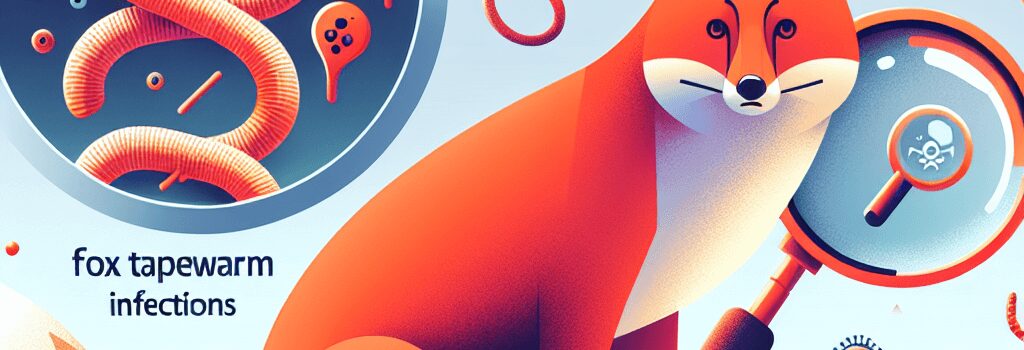Threat of Fox Tapeworm Infections: Diagnosis and Treatment Insights

Accidentally ingesting fox feces may sound like a low-probability prank, but for the few who do, the consequences can be dire. The parasitic tapeworm Echinococcus multilocularis—commonly called the fox tapeworm—establishes indolent, cancer-mimicking cysts in the liver and other organs, leading to a disease known as alveolar echinococcosis (AE). A newly published 50-year Swiss retrospective in Emerging Infectious Diseases highlights not only a rising incidence of AE but also technical advances that promise better detection and less invasive treatment.
Meet the Fox Tapeworm: Lifecycle and Pathogenesis
- Definitive hosts: Red foxes (Vulpes vulpes), coyotes (Canis latrans), dogs and other canids harbor adult worms in their small intestine.
- Egg dissemination: Each adult tapeworm sheds up to 20,000 eggs per day, excreted in feces and contaminating soil, water or produce.
- Intermediate hosts: Rodents (voles, lemmings) ingest eggs; oncospheres hatch, use six─hooked larval forms to penetrate the gut wall, and migrate via the portal circulation to the liver.
- Metacestode development: In the liver parenchyma, parasites form multi-chambered, thin-walled alveolar cysts that proliferate by exogenous budding—akin to malignant tumors, with central necrosis and potential “metastases” to lungs, brain, heart or bone.
- Human spillover: Humans are accidental dead-end hosts. Eggs enter via fecal–oral transmission, with an asymptomatic incubation of 5–15 years before cystic masses become radiologically apparent.
Insights from the 50-Year Swiss Retrospective
Researchers at the University Hospital of Zurich reviewed 334 AE cases (1973–2022). Key findings include:
- Median age at diagnosis: 57.5 years; slight male predominance (55%).
- Surgical resection was performed in 45% (151/334) of cases; 94% (315/334) received benzimidazole therapy (albendazole 10–15 mg/kg/day or mebendazole 40–50 mg/kg/day).
- Overall 10-year survival exceeded 80% under combined drug and surgical management; only 13 deaths were directly attributable to AE.
- Relative survival diverged from matched Swiss population curves after five years, suggesting comorbidities rather than AE per se as the main driver of late mortality.
- Incident cases rose sharply after 2000, correlated with increased cross-sectional imaging and incidental detection of asymptomatic cysts.
Advanced Diagnostic Techniques
Emerging imaging and AI-powered approaches are transforming AE detection:
- Contrast-enhanced ultrasonography (CEUS): Real-time vascular mapping of cyst margins helps differentiate AE lesions from hepatic carcinoma (sensitivity up to 92%, specificity 89%).
- 18F-FDG PET/CT: Quantifies metabolic activity in cyst walls; serial standardized uptake value (SUV) measurements guide therapy response.
- Deep learning segmentation: Neural networks trained on multi-modal scans can detect early AE nodules <5 mm in diameter, reducing the average diagnostic delay by 2–3 years.
- Next-generation sequencing: Metagenomic analysis of biopsy fluid identifies E. multilocularis DNA with 98% accuracy, even in atypical extra-hepatic sites.
Treatment Landscape and Emerging Therapies
While radical hepatectomy remains curative for localized lesions, modern management increasingly favors long-term benzimidazole therapy and investigational agents:
- Pharmacokinetics of benzimidazoles: Albendazole sulfoxide—the active metabolite—achieves peak plasma levels in 2–5 hours; therapeutic trough concentrations >0.5 µg/mL correlate with halted cyst growth.
- Combination strategies: Albendazole plus praziquantel shows additive protoscolecidal effects in vitro, though human trials are ongoing.
- Novel molecules: Ivermectin derivatives and benzoxaboroles targeting the parasite’s leucyl tRNA synthetase are in preclinical development.
- Interventional radiology: Percutaneous cyst drainage with injection of hypertonic saline or ethanol (PAIR technique) debulks large lesions, reducing surgical morbidity.
Epidemiological Trends and Ecological Drivers
AE incidence is rising across the Northern Hemisphere due to multiple factors:
- Urbanization of definitive hosts: Coyotes and foxes increasingly occupy periurban spaces, elevating human exposure risk—especially in Alberta, Canada, where 2021 studies reported a 300% case increase over two decades.
- Climate change: Warmer winters and reduced snow cover boost vole population cycles, amplifying intermediate host density and egg prevalence in the environment.
- Improved surveillance: Broader use of cross-sectional imaging in routine health screenings leads to more incidental findings of asymptomatic AE.
Future Directions and Research Gaps
Key areas for further investigation include:
- Vaccine development: Recombinant oncosphere antigens show promise in rodent models; clinical trials are needed to evaluate protective immunity in humans and domestic dogs.
- Gene drive strategies: CRISPR/Cas9 systems targeting fertility genes in fox populations are under theoretical consideration to reduce definitive host carriage.
- AI-driven risk modeling: Integrating satellite data, host movement tracking, and climate variables could forecast new hotspots for targeted public health interventions.
- Cost-effectiveness analyses: Comparative studies of radical surgery vs. prolonged benzimidazole therapy in different age cohorts will refine treatment guidelines.
Although AE remains relatively rare, its silent incubation, tumor-like progression, and high mortality underscore the need for heightened awareness among clinicians, public health officials, and at-risk populations. Advances in imaging, molecular diagnostics, and antiparasitic therapies are reshaping management, but interdisciplinary research and ecological surveillance will be critical to curb this emerging threat.